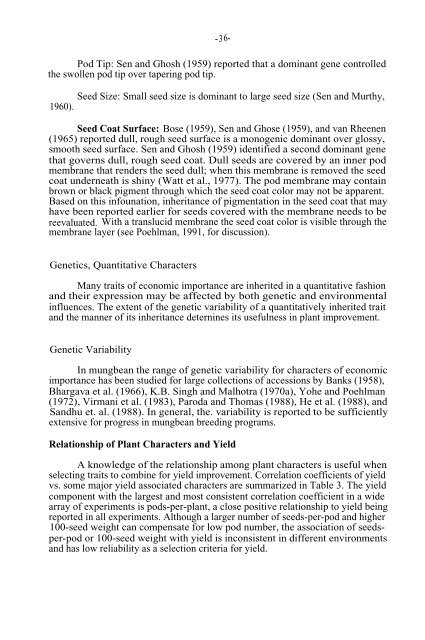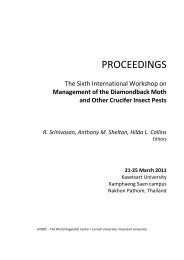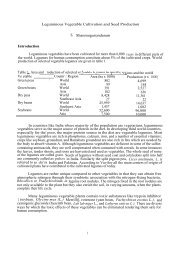MUNGBEAN VARIETAL IMPROVEMENT S. Shanmugasundaram
MUNGBEAN VARIETAL IMPROVEMENT S. Shanmugasundaram
MUNGBEAN VARIETAL IMPROVEMENT S. Shanmugasundaram
You also want an ePaper? Increase the reach of your titles
YUMPU automatically turns print PDFs into web optimized ePapers that Google loves.
-36-<br />
Pod Tip: Sen and Ghosh (1959) reported that a dominant gene controlled<br />
the swollen pod tip over tapering pod tip.<br />
1960).<br />
Seed Size: Small seed size is dominant to large seed size (Sen and Murthy,<br />
Seed Coat Surface: Bose (1959), Sen and Ghose (1959), and van Rheenen<br />
(1965) reported dull, rough seed surface is a monogenic dominant over glossy,<br />
smooth seed surface. Sen and Ghosh (1959) identified a second dominant gene<br />
that governs dull, rough seed coat. Dull seeds are covered by an inner pod<br />
membrane that renders the seed dull; when this membrane is removed the seed<br />
coat underneath is shiny (Watt et al., 1977). The pod membrane may contain<br />
brown or black pigment through which the seed coat color may not be apparent.<br />
Based on this infounation, inheritance of pigmentation in the seed coat that may<br />
have been reported earlier for seeds covered with the membrane needs to be<br />
reevaluated. With a translucid membrane the seed coat color is visible through the<br />
membrane layer (see Poehlman, 1991, for discussion).<br />
Genetics, Quantitative Characters<br />
Many traits of economic importance are inherited in a quantitative fashion<br />
and their expression may be affected by both genetic and environmental<br />
influences. The extent of the genetic variability of a quantitatively inherited trait<br />
and the manner of its inheritance deternines its usefulness in plant improvement.<br />
Genetic Variability<br />
In mungbean the range of genetic variability for characters of economic<br />
importance has been studied for large collections of accessions by Banks (1958),<br />
Bhargava et al. (1966), K.B. Singh and Malhotra (1970a), Yohe and Poehlman<br />
(1972), Virmani et al. (1983), Paroda and Thomas (1988), He et al. (1988), and<br />
Sandhu et. al. (1988). In general, the. variability is reported to be sufficiently<br />
extensive for progress in mungbean breeding programs.<br />
Relationship of Plant Characters and Yield<br />
A knowledge of the relationship among plant characters is useful when<br />
selecting traits to combine for yield improvement. Correlation coefficients of yield<br />
vs. some major yield associated characters are summarized in Table 3. The yield<br />
component with the largest and most consistent correlation coefficient in a wide<br />
array of experiments is pods-per-plant, a close positive relationship to yield being<br />
reported in all experiments. Although a larger number of seeds-per-pod and higher<br />
100-seed weight can compensate for low pod number, the association of seedsper-pod<br />
or 100-seed weight with yield is inconsistent in different environments<br />
and has low reliability as a selection criteria for yield.

















